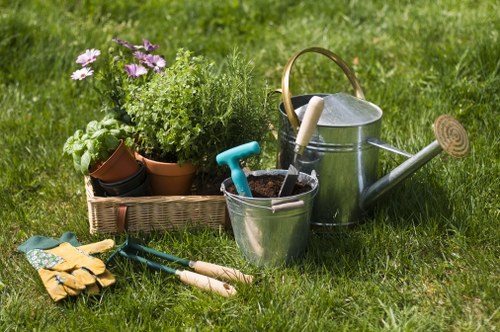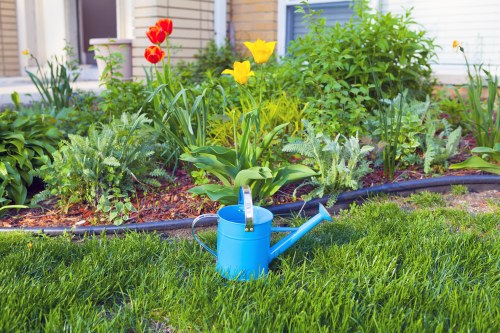Lawn Mowing Aperfield: Achieving the Perfect Green Space

Maintaining a beautifully manicured lawn in Aperfield is a goal many homeowners strive for. A well-kept lawn not only enhances the aesthetic appeal of your property but also provides a serene environment for relaxation and recreation. Lawn mowing is a fundamental aspect of lawn care, and understanding the best practices can make a significant difference in the health and appearance of your grass.
In Aperfield, the climate and soil conditions play a crucial role in determining the type of grass that thrives best. Selecting the right grass species is the first step towards establishing a lush, green lawn. Additionally, regular mowing helps in promoting healthy growth by removing the top portion of the grass blades, encouraging the roots to grow deeper and stronger.
However, lawn mowing isn't just about cutting the grass. It's about doing it correctly to avoid damaging the lawn and ensuring it remains vibrant throughout the seasons. This article will delve into various aspects of lawn mowing in Aperfield, providing you with the knowledge needed to maintain a healthy and beautiful lawn.
The Importance of Proper Lawn Mowing

Proper lawn mowing is essential for several reasons. It helps in controlling weed growth, managing pests, and maintaining the overall health of the lawn. By cutting the grass at the right height, you can prevent weeds from taking over and reduce the chances of pest infestations.
Moreover, regular mowing ensures that the grass is evenly cut, which not only makes your lawn look tidy but also promotes uniform growth. Uneven mowing can lead to patchy grass and an unattractive appearance. Therefore, investing time and effort into proper mowing techniques is well worth it.
Another significant benefit of proper lawn mowing is water conservation. Taller grass shades the soil, reducing evaporation and allowing the roots to access more water. This means your lawn requires less frequent watering, which is both environmentally friendly and cost-effective.
Choosing the Right Mowing Equipment

Selecting the appropriate mowing equipment is vital for achieving the best results. In Aperfield, where lawns vary in size and terrain, having the right tools can make the task easier and more efficient.
- Push Mowers: Ideal for small to medium-sized lawns, push mowers are environmentally friendly and require no fuel. They are easy to maneuver and maintain.
- Gas-Powered Mowers: Suitable for larger lawns, gas-powered mowers offer more power and can handle thick grass with ease. However, they require regular maintenance and fuel.
- Electric Mowers: Offering a balance between push and gas-powered mowers, electric mowers are quieter and produce zero emissions, making them a greener choice.
- Robotic Mowers: For those seeking convenience, robotic mowers autonomously maintain the lawn. They are programmable and can save time, though they come at a higher initial cost.
Choosing the right mower depends on the size of your lawn, the type of grass, and your personal preferences. Investing in quality equipment will ensure a smoother mowing experience and better lawn health.
Best Practices for Mowing Your Lawn

Implementing the best mowing practices is key to maintaining a healthy lawn. Here are some essential tips to consider:
- Set the Right Mowing Height: Different grass types require different mowing heights. Generally, it's advisable to mow at a height that removes no more than one-third of the grass blade's length.
- Mow When the Grass is Dry: Mowing wet grass can lead to uneven cuts and clumping, which can damage the lawn. Always mow when the grass is dry for the best results.
- Change Mowing Patterns: Varying your mowing direction each time helps prevent soil compaction and ensures even growth.
- Keep Mower Blades Sharp: Dull blades tear the grass, leading to ragged edges and increasing susceptibility to diseases. Regularly sharpen or replace mower blades.
- Leave the Grass Clippings: Mulching mowers can chop grass clippings into fine pieces that decompose quickly, returning nutrients to the soil and reducing the need for additional fertilizers.
Adhering to these best practices will not only improve the appearance of your lawn but also enhance its resilience against pests and diseases.
Seasonal Lawn Mowing Tips

Different seasons require different lawn mowing strategies to ensure optimal growth and health. Here are some seasonal tips tailored for Aperfield's climate:
Spring
As the lawn begins to grow after winter, it's essential to start mowing regularly. Set your mower to a higher height to allow the grass to establish strong roots.
Summer
During the hot months, raise the mowing height to provide shade to the roots and retain moisture. Water your lawn deeply but infrequently to promote drought resistance.
Fall
Prepare your lawn for winter by gradually lowering the mowing height. This helps prevent snow mold and other winter diseases.
Winter
In colder months, avoid mowing unless necessary. If a mow is needed, ensure the grass is dry to prevent damage.
Local Lawn Mowing Services in Aperfield
For those who prefer professional assistance, Aperfield boasts a range of lawn mowing services tailored to different needs and budgets. Professional landscapers can provide comprehensive lawn care, including mowing, edging, fertilizing, and pest control.
Hiring a local service ensures that the professionals are familiar with Aperfield's specific climate and soil conditions, allowing them to offer personalized care for your lawn. Additionally, local services often support the community and contribute to the local economy.
When selecting a lawn mowing service, consider factors such as reputation, experience, and the range of services offered. Reading reviews and seeking recommendations can help you choose a reliable provider that meets your expectations.
Eco-Friendly Lawn Mowing Practices
Embracing eco-friendly lawn mowing practices not only benefits the environment but also contributes to the long-term health of your lawn. Here are some sustainable practices to consider:
- Use a Reel Mower: Reel mowers are powered by human effort and produce zero emissions, making them an environmentally friendly option.
- Implement Mulching: Mulching mowers chop grass clippings finely, which can be left on the lawn to decompose naturally, reducing the need for chemical fertilizers.
- Opt for Electric or Solar-Powered Mowers: These mowers are quieter and produce no direct emissions, reducing your carbon footprint.
- Reduce Mowing Frequency: Allowing the grass to grow slightly longer can improve its ability to withstand drought and reduce the energy required for mowing.
- Compost Grass Clippings: Composting clippings can create a nutrient-rich soil amendment for your garden.
Adopting these eco-friendly practices promotes sustainability while maintaining a healthy and attractive lawn.
Common Lawn Mowing Mistakes to Avoid
Avoiding common mowing mistakes can significantly enhance the health and appearance of your lawn. Here are some pitfalls to watch out for:
- Mowing Too Short: Cutting the grass too short can stress the plants, making them more susceptible to weeds, pests, and diseases.
- Neglecting Blade Maintenance: Dull mower blades tear the grass, leading to a ragged appearance and increased vulnerability to pathogens.
- Ignoring Lawn Health Signs: Failing to address issues like pests, diseases, or nutrient deficiencies can worsen the lawn's condition over time.
- Mowing Wet Grass: Wet grass is more prone to clumping and uneven cuts, which can damage the lawn.
- Inconsistent Mowing Patterns: Regularly changing mowing patterns helps prevent soil compaction and promotes even growth.
Being aware of these mistakes and taking proactive measures can ensure your lawn remains healthy and visually appealing.
Maintaining Lawn Equipment
Proper maintenance of your lawn mowing equipment is essential for efficient performance and longevity. Here are some maintenance tips:
- Regular Cleaning: After each use, clean your mower to remove grass clippings and debris. This prevents rust and keeps the mower functioning smoothly.
- Blade Sharpening: Sharpen the mower blades at least once a mowing season. Sharp blades provide a clean cut, promoting healthier grass growth.
- Check Fuel and Oil Levels: For gas-powered mowers, regularly check and maintain fuel and oil levels to ensure optimal performance.
- Inspect for Wear and Tear: Periodically inspect your mower for any signs of damage or wear. Replace or repair parts as needed to avoid breakdowns.
- Store Properly: Store your mower in a dry, sheltered place to protect it from the elements and extend its lifespan.
Consistent maintenance not only improves the efficiency of your mowing tasks but also saves you money in the long run by preventing costly repairs.
Enhancing Your Lawn Beyond Mowing
While mowing is a crucial aspect of lawn care, other practices contribute to a thriving lawn. Consider integrating the following elements into your lawn care routine:
Watering
Proper watering is essential for maintaining healthy grass. Water deeply and infrequently to encourage deep root growth. Early morning is the best time to water to minimize evaporation.
Fertilizing
Applying the right fertilizers provides necessary nutrients that promote vigorous growth and resilience against pests and diseases. Choose fertilizers based on your grass type and soil condition.
Weed Control
Implementing effective weed control measures, such as manual removal or using eco-friendly herbicides, helps maintain the lawn's pristine appearance and prevents competition for nutrients.
Aerating
Aerating the soil improves its structure, allowing water, air, and nutrients to penetrate deeper. This practice enhances root development and overall lawn health.
Overseeding
Overseeding involves planting new grass seeds into the existing lawn to fill in bare spots and promote a thicker, more lush appearance.
Local Considerations for Aperfield Lawns
Aperfield's unique climate and soil conditions require specific lawn care strategies. Understanding the local environment helps in choosing the right grass type and maintenance practices.
The region experiences moderate rainfall and seasonal temperature variations, making it suitable for cool-season grasses like fescue and ryegrass. However, selecting a grass variety that is drought-tolerant can be beneficial during the hotter months.
Additionally, the soil in Aperfield tends to be clay-heavy, which can affect drainage and nutrient availability. Amending the soil with organic matter and ensuring proper aeration can mitigate these challenges, promoting a healthier lawn.
Conclusion
Achieving and maintaining a beautiful lawn in Aperfield involves more than just regular mowing. It requires a comprehensive approach that includes selecting the right grass, using appropriate mowing techniques, and integrating other lawn care practices. By following the guidelines outlined in this article, homeowners can enjoy a vibrant and healthy lawn that enhances the beauty and value of their property.
Whether you choose to mow your lawn yourself or hire a professional service, understanding the principles of effective lawn care is essential. Embrace sustainable practices, stay informed about local conditions, and invest in quality equipment to ensure your lawn remains a source of pride and enjoyment for years to come.
Frequently Asked Questions
- How often should I mow my lawn in Aperfield?
Generally, you should mow your lawn once a week during the growing season. However, this can vary depending on the grass type and growth rate.
- What is the ideal mowing height for cool-season grasses?
For cool-season grasses like fescue and ryegrass, the ideal mowing height is typically between 2.5 to 3.5 inches.
- Can I mow my lawn when it's wet?
It's best to mow when the grass is dry. Wet grass can lead to uneven cuts and clumping, which may damage the lawn.
- How can I make my lawn more drought-resistant?
To enhance drought resistance, mow at a higher height, water deeply but infrequently, and choose drought-tolerant grass varieties.
- Should I bag my grass clippings?
Leaving grass clippings on the lawn as mulch can provide nutrients and reduce the need for additional fertilizers. However, if clippings are too thick, it may be necessary to bag them to prevent matting.